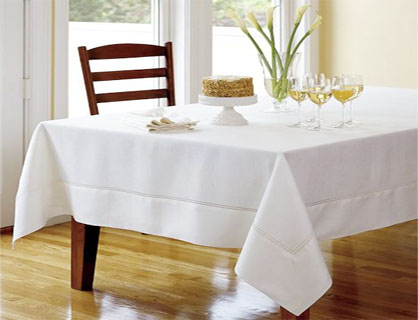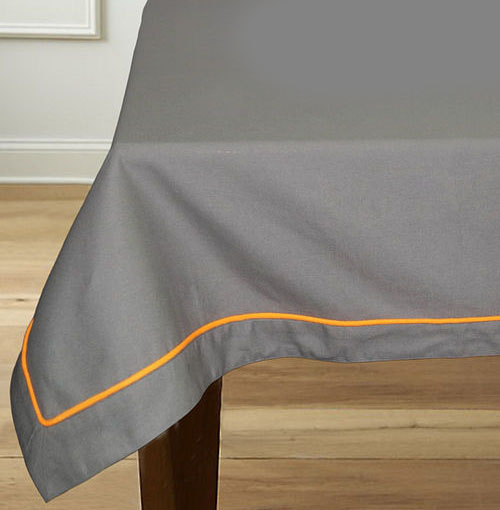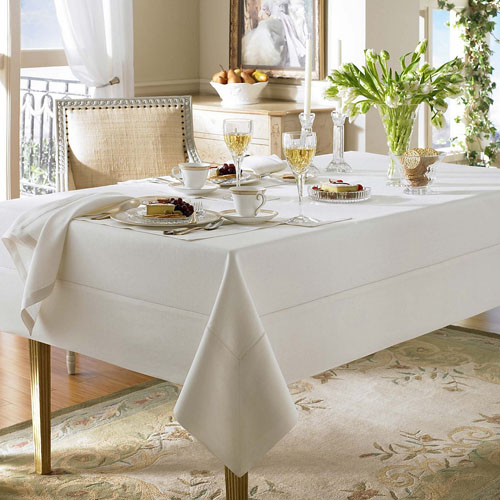

Tablecloths have been used for decades to keep a table safe from the food placed upon it, but also to add to the style and colour of the place settings and the room in general. They are not always needed or wanted and can occasionally be a hindrance to the occasion.
Daily Use
Daily use tablecloths will protect your table from minor spills, food dropping on it, and condensation from drinks. It will not protect against large spills, or very hot beverages, a coaster or other protective measures should be taken in those cases. In addition to protecting your table a tablecloth can add colour and personality to your space. They are easily changeable for season, colour schemes, or holidays and can be an affordable and fast way to adjust your space whenever you like.
Special Events
When having an event or gathering a tablecloth can be used to tie together a theme or colour scheme. They can be used to provide a backdrop for the meal, and choice of colour can even affect the appetite and make the food stand out more. It can create an appearance of elegance and sophistication when using appropriate coloured tablecloths for your event but can inversely be fun and colourful for children’s parties. A tablecloth can help to set the mood and expectations of any social gathering.
When hosting a special even such as a wedding, anniversary, or even retirement party, often the tables are rented. These rented tables are frequently wooden or plastic folding tables with no elegance or beauty, so covering them with a tablecloth will change the appearance of the entire room and bring elegance to the meal. This also protects the table from elbows, plates, and small spills, while offering the guest a lovely place to eat from that is protected from any previous uses of the table. They are sanitary, easily cleaned after the event, and can be used frequently.
Life Span of Your Table
A tablecloth is a wonderful addition to any table. It will defend a wooden top table from water rings and help protect against heat damage, and protect a glass table from smudges and fingerprints. They will help to extend the life of your table no matter it’s material and assist in getting the most use for your money. When placemats in either matching or contrasting colours are added they create a visual that is both lovely and protective. Placemats will create a comfortable eating area for each guest or diner without encroaching on others spaces around them, while also providing added protection not only for your table but also for the tablecloth itself, as they will catch more spills and diffuse more heat away from the table itself.
To increase the life span of your table always use a tablecloth, both when seating and eating at the table and when it is not in use. This will protect it not only from the dangers associated with eating on it but also from things that are often tossed upon a table such as keys or books, but also from build up and residue from dust found in the air, pet hair, and any residue created by cooking near a kitchen table. The thicker the tablecloth the more protection it offers your table, and the longer your table will last without damages.
If your table is already well used it may be showing signs of damage already. Some small scratches, dents, and even chips may be present. Adding a tablecloth to a table that is already slightly damaged will cover all the damages and allow you to use your table cloth for many more years. It will not cover large dents or cracks, but surface damages such as water rings and heat marks are easily covered with a well placed tablecloth of your choosing. Other misadventures that can be covered include pain, table surface material, felt marks, discolorations, bleach damage, cleaning damage, spills, and every day wear and tear. To get the most out of your table use a tablecloth to not only protect it before damage occurs but also to cover slight damages after they happen.

Noise
Due to the insulating properties of a tablecloth it will not only decrease damage from spills and dropped food, it will also decrease the noise level in the room. The layer of padding added over the table will dampen the sound of plates and glasses being set down over and over during a meal, as well as decreasing the noise created by silverware and other items on the table. This can create a more enjoyable conversation and help to improve the flow of a meal around the table.
This also functions as a sound dampener for the other noises, as noise will bounce off the hard surface of a table much easier, where as a table cloth will absorb some of the sound waves around the room and help to decrease the overall noise levels in the space. It will lower the echo that occurs in almost every room as well.
When not to use a Tablecloth
While tablecloths have been used for decades to protect tables and add elegance to any occasion, they also require maintenance. Often when young children are present a tablecloth will require extra cleaning, acquire stains through regular use, be removed often for other uses of the table, and may even be a hazard when tugged on or accidentally pulled. For some occasions and in some homes it is best to allow the beauty of the table to show for itself and keep the table cloth for special occasions. This will allow you to enjoy your table all day every day while admiring it’s beautiful finish, with not extra steps when you want to use it for any other purpose.
There is rarely one set answer for any question, and whether or not to use a tablecloth is no exception. While it offers protection, design, and can dampen noise, it also requires cleaning, washing, and must be the right size for the table. For most occasions it is a lovely addition and will add years to the life of your table, while in some homes it may be a hindrance to the multiple uses of something like a kitchen table.
 |
WRITTEN BY Kassandra Foreman
I do freelance writing because I enjoy writing and it allows me to have a flexible schedule and the freedom to make it fit in the lifestyle I want to have.
|



